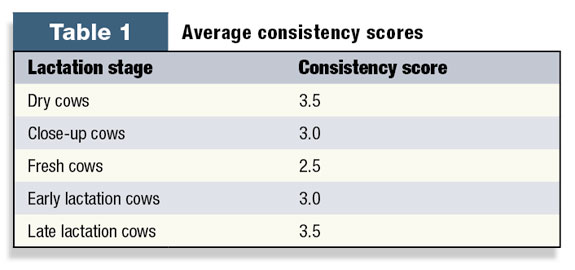Feed analysis doesn’t stop at the bunk. A lot can be discovered at the other end of the digestive tract. “Fresh, undisturbed piles of feces or droppings may provide valuable clues and should be part of your tool box when evaluating the nutritional status of the dairy herd,” said Mike Hutjens, dairy specialist at the University of Illinois. He outlined three different methods to use at the Four-State Dairy Nutrition Conference in Dubuque, Iowa, earlier this summer.
Fecal starch analysis
The need to optimize the starch digestibility in the dairy cow continues to rise as the price of corn increases. Analyzing fecal starch is one way to measure that digestibility, yet its use is kind of controversial, Hutjens said. There is tremendous variation in terms of fecal starch content and determining the correct formula to use is still up for discussion.
The University of Pennsylvania published a formula to predict total tract starch digestibility using fecal starch and fecal lignin along with ration starch and lignin. It concluded that for each increase in fecal starch, the potential loss in milk yield was 0.7 pound per day with a range of 4 to 10 percent starch in group or herd values. Two other labs reported starch content ranging from 0.2 to 38.9 percent.
The University of Illinois decided to do its own field study with 19 Holstein herds. Four to five cow pies were recovered from each pen. They were mixed and analyzed. Reported results found up to 96 percent of starch was digested. At 70 percent digestion you could still see bits of corn in the pies, Hutjens said.
Based on these results, Illinois researchers developed a different equation for determining starch digestibility. According to Hutjens, more studies are needed to confirm and/or refine the formula.
Dairy managers and consultants wanting to add fecal starch and lignin analysis to monitor starch utilization should note that it is offered by some laboratories. Of the labs Hutjens researched, they were running $10 to $20 per sample for starch and $16 per sample for lignin. He recommends running only a fecal starch test, as the results for lignin may not be worth the additional cost at this time.
Manure washing
Washing manure can help identify if feeds are being processed correctly before being fed to the animal.
To do this, Hutjens said he collects three to five samples per pen or group using a coffee cup. He washes the cup of manure with a stream of warm water to remove the digested material through a No. 8 screen.
If barley or corn grain with pieces of white starch are present, it can indicate that some feed value was lost. If those pieces are hard, additional grinding may be needed to expose the starch before feeding.
Hard corn kernels remaining could be the result of mature and/or dry corn silage.
Whole cottonseeds and the passage of split soybeans reflect a loss of feed nutrients. If feeding four to five pounds of cottonseed a day, more than six seeds is too many, he said. If roasted soybean seeds are hard, they need additional processing.
Forage pieces more than 1/2-inch in length suggest a lack of long forage particles to maintain the rumen mat.
The interpretation of these results is certainly subjective. Hutjens recommended that if using the manure-washing technique, an answer or protocol to what is found must be in place so action can be taken if needed.
Consistency
A third tool Hutjens uses is consistency scoring of manure. This aids in analyzing the ration and digestive function of the cow.
For this test, visually score the manure consistency from 10 to 15 cows per pen. Be sure to record the animal number with it, just in case a score or two vary from the norm of the pen. The production and health records could then be pulled for those animals to make additional conclusions.
The following five-point scale developed in Michigan should be used when scoring:
1. This manure is very liquid with the consistency of pea soup. The manure may actually âarcâ from the cow. Excess protein or starch, too much mineral or lack of fiber can lead to this score. Excess urea in the hindgut can create an osmotic gradient, drawing water in the manure. Cows with diarrhea will be in this category.
2. This manure appears runny and does not form a distinct pile. It will measure less than one inch in height and splatters when it hits the ground or concrete. Cows on lush pasture may have this manure score. Low fiber or a lack of functional fiber can also lead to this manure score.
3. This is the optimal score. The manure has a porridge-like appearance, will stack up 1.5 to 2 inches, have several concentric rings, a small depression or dimple in the middle, make a plopping sound when it hits concrete floors, and it will stick to the toe of your shoe.
4. This manure is thicker and stacks up over 2 inches. Dry cows and older heifers may have this type of manure. (This may reflect that low-quality forages are fed and/or a shortage of protein.) Adding more grain or protein or improving forage quality can lower this manure score.
5. This manure appears as firm fecal balls. Feeding a straw-based diet or dehydration could contribute to this score. Cows with a digestive blockage may exhibit this score.

When interpreting the results, scores 1 and 5 may reflect a health problem besides dietary limitations. Less than 2 and more than 4 may reflect a need to rebalance the ration. Scores can also shift throughout a cowâs lactation. (See Table 1 , based on limited work by the University of Illinois.)
Increasing the amount of degradable, soluble or total protein; decreasing the amount or physical form of the fiber; increasing starch level; decreasing grain particle size (such as fine grinding or steam flaking); and consuming excess minerals (especially potassium and sodium) can cause manure scores to decline.
Whether one or all three methods are used, there is certainly something that can be learned about the ration from looking at it at the other end of the digestion tract. PD
PHOTO : Scoring undisturbed manure piles for consistency can help in determining how the cows are digesting their ration. Photo by Karen Lee.

-
Karen Lee
- Midwest Editor
- Progressive Dairyman
- Email Karen Lee




